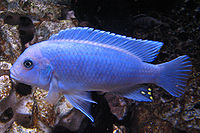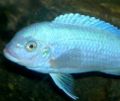Difference between revisions of "Maylandia callainos"
From The Aquarium Wiki
m |
|||
| Line 36: | Line 36: | ||
|max_water_hardness=15 | |max_water_hardness=15 | ||
}} | }} | ||
| − | + | ||
| − | + | == Origin == | |
| − | + | :This species is indigenous to Lake Malawi. It primarily inhabits the Nkhata Bay region but can additionally be found dwelling in the northeast from Lkombe to Puulu. | |
| − | + | ||
| − | + | ||
| − | + | == Sexing == | |
| − | + | :Adult males are distinguished from their female counterparts by their more vibrant blue sheen, steeper forehead, more eggspots, pointier fins and generally larger size. | |
| + | |||
| + | |||
| + | == Tank compatibility == | ||
| + | :Like other mbuna species, this is an aggressive and territorial animal that should not be housed together with peaceful and placid tank mates. However, it will be able to co-exist with other species that are similarly aggressive. | ||
| + | |||
| + | |||
| + | == Diet == | ||
| + | :In the wild, they graze on algae that they scrape off rock surfaces. They also feed on plankton that reside within the water column. It is necessary to duplicate their primarily herbivorous diet in captivity by feeding them food that is primarily vegetable derived. A quality pellet or flake food is recommended, together with spirulina supplements. Regular treats of carrots, peas and zucchini would also benefit them. | ||
| + | |||
| + | |||
| + | == Feeding regime == | ||
| + | :Feed them at least twice a day. Be careful not to administer more food than can be consumed within 20 minutes. | ||
| + | |||
| + | |||
| + | == Environment specifics == | ||
| + | :Their natural habitat consists of the rocky crevices which they typically inhabit. This environment should be replicated in captivity. Abundant rockwork will ensure adequate access to shelter, territorial markers and spawning sites. It is important to note that rocky crevices will provide females with some respite from the harrasment of males. Being active diggers, they will appreciate a substrate layer consisting of sand or very small gravel that has a depth of several inches. | ||
:In order to replicate the waters of their natural habitat, hobbyists will want to provide plenty of water surface agitation or wet/dry filtration to provide high levels of dissolved oxygen within the aquarium | :In order to replicate the waters of their natural habitat, hobbyists will want to provide plenty of water surface agitation or wet/dry filtration to provide high levels of dissolved oxygen within the aquarium | ||
| − | + | ||
| − | + | ||
| − | + | == Behaviour == | |
| + | :Males are often hostile to one another and become especially aggressive during the spawning season. This makes it essential to provide ample space so as to mitigate the frequency of violent clashes. It is also necessary to maintain a ratio that has one male to several females. | ||
| + | |||
| + | |||
| + | == Identification == | ||
| + | :They tend to be a pale blue with seven to eight blue-black bars and four orange egg-shaped spots on the anal fin. | ||
| + | |||
| + | |||
{{Categories | {{Categories | ||
|Category=Fish, Fish (Freshwater), Cichlids, Cichlids (African), Cichlids (Lake Malawi) | |Category=Fish, Fish (Freshwater), Cichlids, Cichlids (African), Cichlids (Lake Malawi) | ||
Latest revision as of 03:08, 13 December 2017
Cobalt Cichlid
Maylandia callainos
208 Litres (55 US G.)
12.7-15.2cm (5-6 ")
Freshwater
7.8 - 8.6
25.6-27.8°C (78 -82 °F)
8-15 °d
2:3 M:F
2-5 years
Family
Cichlidae
Contents
Additional names
- Cobalt Cichlid, Cobalt Blue Zebra Cichlid, Cobalt Mbuna, Cobalt Zebra
Additional scientific names
- Pseudotropheus callainos, Metriaclima callainos
Origin[edit]
- This species is indigenous to Lake Malawi. It primarily inhabits the Nkhata Bay region but can additionally be found dwelling in the northeast from Lkombe to Puulu.
Sexing[edit]
- Adult males are distinguished from their female counterparts by their more vibrant blue sheen, steeper forehead, more eggspots, pointier fins and generally larger size.
Tank compatibility[edit]
- Like other mbuna species, this is an aggressive and territorial animal that should not be housed together with peaceful and placid tank mates. However, it will be able to co-exist with other species that are similarly aggressive.
Diet[edit]
- In the wild, they graze on algae that they scrape off rock surfaces. They also feed on plankton that reside within the water column. It is necessary to duplicate their primarily herbivorous diet in captivity by feeding them food that is primarily vegetable derived. A quality pellet or flake food is recommended, together with spirulina supplements. Regular treats of carrots, peas and zucchini would also benefit them.
Feeding regime[edit]
- Feed them at least twice a day. Be careful not to administer more food than can be consumed within 20 minutes.
Environment specifics[edit]
- Their natural habitat consists of the rocky crevices which they typically inhabit. This environment should be replicated in captivity. Abundant rockwork will ensure adequate access to shelter, territorial markers and spawning sites. It is important to note that rocky crevices will provide females with some respite from the harrasment of males. Being active diggers, they will appreciate a substrate layer consisting of sand or very small gravel that has a depth of several inches.
- In order to replicate the waters of their natural habitat, hobbyists will want to provide plenty of water surface agitation or wet/dry filtration to provide high levels of dissolved oxygen within the aquarium
Behaviour[edit]
- Males are often hostile to one another and become especially aggressive during the spawning season. This makes it essential to provide ample space so as to mitigate the frequency of violent clashes. It is also necessary to maintain a ratio that has one male to several females.
Identification[edit]
- They tend to be a pale blue with seven to eight blue-black bars and four orange egg-shaped spots on the anal fin.
Pictures[edit]
Videos[edit]
External links[edit]
- Fishbase (Mirrors:
 )
)

